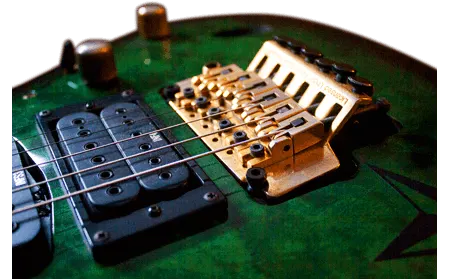A reader recently asked the question “What makes a guitar expensive?” that seems obvious on the surface until you realize you haven’t really considered the details.
We all tend to brush questions like these off, as if “well, duh, because they’re better” is a sufficient answer. That’s actually a non-answer and we’ll have none of that here!

So let’s get to the bottom of why some guitars are so expensive…
What Makes a Guitar Expensive?
Question:
What is the deal with some guitars being so much more expensive than others? Why are guitars so expensive in general? When I look at the features and general technical specifications they all seem to be the same for the most part.
I’m not talking about handmade or vintage guitars, only the run-of-the-mill electric guitars. How can there be such huge price variances and are the costlier ones worth it?
Thanks,
Brandon
Answer:
Brandon, thanks for reaching out. You narrowed the discussion down nicely for us to just electric guitars, which gets us away from the custom woodworking done by hand by professional luthiers on acoustic guitars. Some of the reasons that apply to acoustic guitars still applies to electrics though.
We can summarize the entire ordeal:
Inexpensive guitars are made with materials that are cheaper for the manufacturer to purchase, using less rigid and thus less costly methods of construction, and all completed by lower wage workers.
On the other hand, expensive guitars are created in the opposite fashion. On top of this, the consumer has to help cover the cost of research and development, marketing, and tight quality assurance to make sure there are very little variances from one product to the next.
If you want to know why expensive guitars command such a price, take the time to compare tiny details like the build and finish of the nut. One will be pristine and the other will resemble a ‘mass-manufactured in a hurry by machines’ feel to it.
Both are likely machined but one has world class tolerances that ensure each piece is perfect, while the cheaper version can pump out masterpieces or less-than-desirable versions as well in an inconsistent manner. It’s a gamble in these cases.
We can’t just leave it at that, though. Let’s get into some details about why there are such huge differences in guitar prices.
Branding & Prestige
A great example of the effect of branding is the ESP Les Paul and the Gibson Les Paul. Chances are that people who aren’t interested in the world of guitar haven’t heard of ESP Guitars coming out of Japan in 1975.
ESP Guitars makes amazing instruments that most of the top metal guitarists prefer, yet they aren’t household names. Meanwhile everyone has heard of Gibson. The same goes for Fender. But unless you’re hunting for the best guitar for metal you can find, you’re probably not familiar with ESP.

How does a company break out of a smaller niche, besides producing a broad range of quality products for such a long time, which clearly ESP Guitars and Gibson both have done for long enough? They have large marketing budgets that they use to become this widely known.
And beyond that they’re able to educate consumers about their high quality models and product runs. Eventually they build a reputation for their quality that may not exceed the quality of a competitor who can’t afford these marketing campaigns. And at the end of the day, the buyers pay a little or a lot more to help fund those campaigns. This prestige and branding comes at a cost.
Tone Wood
A lot of research has gone into determining which woods from which type of trees produce the best acoustic characteristics for guitars due to the way they carry vibrations through them. Once this research was finished and the results established, there became a higher demand for the better woods, and unfortunately lately the supply can’t keep up. There’s actually somewhat of a guitar wood crisis going on globally right now.

Usually a higher demand would be accompanied by a higher supply, but this isn’t possible right now so the price isn’t contained to what may seem like a reasonable level. One way this has been solved is to only use the nicest woods for the ‘top wood’ on the face of the guitar.
Some companies like Ovation have even gone to using a composite plastic material called lyrachord for the backs of even their best acoustic electric guitars. My dad has one of these and it’s very nice, perhaps even preferable.
Beyond this, even in the cheaper woods on the less important areas of the guitar, there comes the question of using laminates or not and the work that comes with trying to steam and bend solid cuts of wood. So there’s always the labor cost associated with working with solid woods as well.
Hardware & Electronics
This is where you can really get deceived by straight comparisons of guitars. Everything may seem equal in terms features, but are those features supported by the highest quality electronics and hardware?
One potentiometer does the same job as any other but is only made to withstand 10,000 twists, while the best may maintain their performance after a million uses. I made those numbers up but they illustrate the point. One will experience wear and tear much sooner and likely performs less well from conception.

Now extrapolate this all the way to your tuners, frets, the bridge, your pickups, the magnets inside the pickups, the diaphragm of the piezoelectric pickup, strap buttons, and so forth. You can take it as granular as you’d like and the most expensive guitars will have done the same, using only the best materials and options available.
Now go back to the research and development discussion and the topic of tolerances in machining the parts, and you can see how we have to pay for all of that for each little piece too. Every expense is passed on to the consumer.
Aesthetics & Extras
Every fancy detail that is added to a guitar requires time, attention, and labor, which are all directly translated to additional costs for the guitarist. The intricate neck inlays, the beautiful patterns around the sound hole of an acoustic guitar, the immaculate sunburst finish… all of these add up.

Now start tacking on the ‘free’ soft-shell case and strap, plus the two-year warranty and damage insurance, the complementary pack of strings, the one-year subscription to some magazine, and the cost of shipping and handling. This all gets bundled into the price of a guitar.
Is It Worth It?
Finally you asked whether or not it’s worth springing for an extra expensive guitar. It depends. If you’re just getting into the game, you’re better off sticking with an option from our list of best beginner guitars.
The reason is that you can’t be sure your passion will still be there when the going gets tough and you have to put in those practice hours while sucking a little less and less. It’s always better to learn on a good guitar, but not an elite guitar.
Save that for when you’re an intermediate or master, and at that point I can say “Yes, it’s worth it.” Those tiny improvements in playability and maintenance can be the tie breaker between you and the hurdle of learning your next set of chops.
That’s what makes a guitar expensive. Hit us back if you want to talk more about it. Thanks for reaching out,
Jared